
Prominent religious shrines dot the Kangra valley landscape and many pilgrims seeking a divine experience visit the monasteries, churches and temples that throng the region annually.
Rooted in ‘tantric’ belief, the most famous temples of Kangra belong to the Shaktipeeth genre that upholds the female divinity as the source of all cosmic energy. Shaktipeeth temples span the entire Himalayan landscape from Kashmir to Assam.
Religious literature narrates a tale about Sati, daughter of King Daksha and wife of Lord Shiva that forms the basis of Shaktipeeth genesis. On one occasion Daksha deliberately insulted Lord Shiva which led to Sati committing suicide by jumping into a sacrificial fire. An angry Shiva, carrying the charred body of his dead wife was instigated to perform the ‘tandava’, a death dance that would have destroyed the universe. To stop Shiva, other gods led by Lord Vishnu severed the body of Sati from his shoulders. The body parts fell over 51 different places in the Himalayas and where ever they landed a Shaktipeeth shrine was born.
The British introduce Christianity into the region in the early 19th century and many churches came up.
While the British laid the foundations of towns like Forsytheganj, McLeodganj and Palampur but it was the arrival of His Holiness Dalai Lama in 1966 that added the strain of Tibetan culture into Kangra Valley. Many prominent monasteries have come up.
The popular religious places in the Shaktipeeth circuit are Chintpurni, Jwalamukhi, Brijeshwari Devi (Kangra) and Chamunda Devi. Other temples deeply revered are Deothsidh and Bhagsunath (Dharamsala).
Repositories to a rich heritage are the temples of Masroor, Baijnath and Sujanpur Tira.
Besides Dharamsala-McLeodganj where the Dalai Lama resides other prominent Buddhist religious sites are around Palampur and Jogindernagar.
The St John’s Churches in the Wilderness at Forsytheganj and Palampur are relics from the British Raj days.
Chintpurni (975 m)
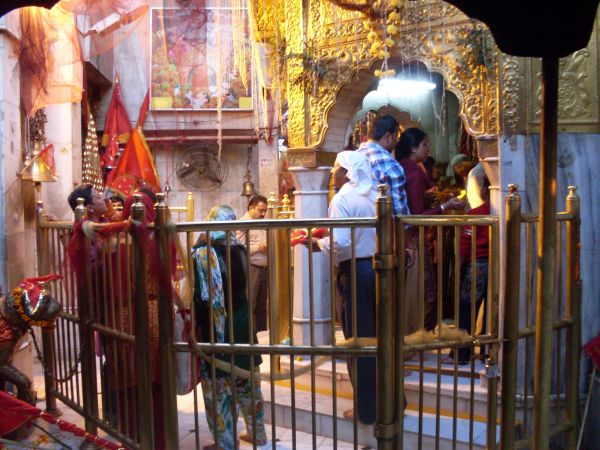
Located on the Shivalik ranges in lower Himalayas, Chintpurni is a popular Shaktipeeth pilgrimage centre. Here ‘Chinnimastika Devi – The Goddess Without a Head’ is worshiped in an anthropomorphic form. The headless pindi of the Devi is worshiped at this temple that was built in the 15th century. The Shaktipeeth legend holds that it was the severed feet of Sati which fell at Chintpurni and gave birth to this holy shrine. The auspicious ‘navratra’ days in March-April and September-October attract thousands of pilgrims to Chintpurni from all over the country.
Getting there
Chintpurni by road is only 43 Kms from Hoshiarpur. It is 35 Km from Jwalamukhi, 84 Km from Dharamsala and 75 Km from Una. Nearest railhead is at Hoshiarpur and the nearest airport is Gaggal (81 Kms).
Circuit
From Hoshiarpur, Chintpurni is an entry point to the pilgrim circuit of Jwalamukhi, Brijeshwari Devi (Kangra), Chamundaji and Deothsidh.
Climate
Summers are warm and light cotton clothing is recommended but winters do get cold and woollens are required.
Deothsidh (925 m)
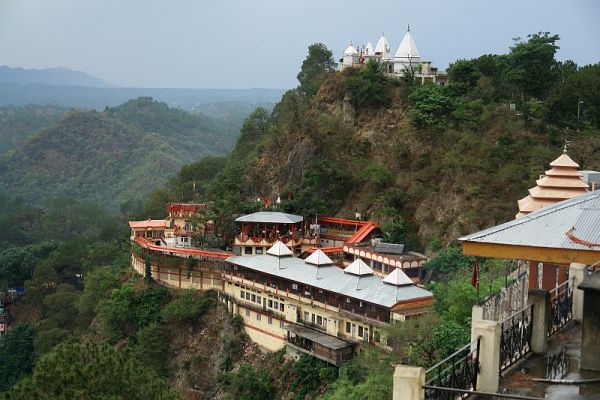
Deothsidh meaning ‘Light of Truth’ is a cave temple shrine high on a spur of a Dhaulagiri hill where devotees for five centuries have been nourishing a sacred fire to burn consistently. This famous pilgrim centre is dedicated to a child saint Baba Balaknath, a deified ascetic of ancient times. At the caves entrance is a shikhar style temple. Nearby are the Mathstha samadhis of Baba Balaknath’s gurus.
Getting There
From the nearest broad gauge trains stations of Pathankot and Chandigarh, Deothsidh by road is 217 Km and 172 Km respectively. From Hamirpur it is 56 Km and from Bilaspur it is 37 Km by road. Nearest airport is at Chandigarh.
Circuit
Deothsidh is a link up pilgrimage place with the Shaktipeeth circuit of Jwalamukhiji, Brijeshwariji, Chamunda Devi and Chintpurniji.
Climate
Winters are mild and woollens are required. Summers are warm and cottons are recommended.
Jwalamukhi (500 m)
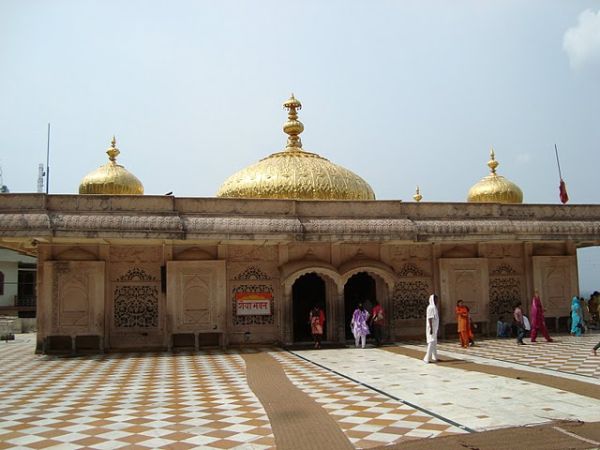
Jwalamukhi is a very famous pilgrimage town, revered for the gold domed temple that does not house a idol. Instead the eternal goddess here is manifest in a natural blue flame emanating from a holy rock sanctum that has been burning so for centuries. Shaktipeeth legends hold Jwalamukhi as the place where the half-burnt tongue of Sati fell. The great Mughal emperor Akbar in 16th century walked to pay obeisance at Jwalamukhi and Maharaja Ranjit Singh of Punjab in 19th century gilded the temple dome in gold. Evening prayers at ‘aarti’ is a grand experience for devotees.
Other temples within easy reach from Jwalamukhi are the nearby shrines of Ashtabhuja, Raghunathji, Nagni Mata, Chaumukha, Panj Teerthi, Mahakaleshwar (Kalesar) and Baglamata.
Getting There
Jwalamukhi by road is 123 Km from Pathankot, 212 Km from Shimla and 473 from Delhi. It is 53 Km from Dharamsala, 37 Km from Kangra and 74 Km from Hoshiarpur. Nearest broad gauge train stations are at Hoshiarpur and Pathankot. Nearest airport at Gaggal is 46 Kms away.
Circuit
Jwalamukhi is an integral part of the popular Chintpurni, Chamundaji, Brijeshwari Devi (Kangra), and Deothsidh (Shahtalai) pilgrim circuit.
Climate
Summer at Jwalamukhi is warm and cotton clothing is recommended but winter get cold and woollens are required.
Brijeshwari Devi – Kangra (768 m)

This is one of the most famous temples in Kangra valley. For many centuries Kangra was the seat of royal power in the region and the fame and wealth of the Brijeshwari Devi temple was legendary. It was also target of many invasions including one by Mahmud of Ghazni, over a thousand years ago. Believers hold that this Shaktipeeth shrine sprung up at the spot where the left breast of dead Sati fell. The temple did become a great centre of ‘tantric’ beliefs. The present temple’s shikhar and two domes were built after the Kangra earthquake of 1905 and draw inspiration from Hindu, Muslim and Sikh architectural styles. Around the main shrine are temples of Tara Devi and Bhairon.
Circuit
Brijeshwari Devi (Kangra) is an integral part of the Chintpurni, Chamundaji, Jwalamukhi and Deothsidh pilgrim circuit.
Getting there
Kangra can be reached by air, train or road. Nearest broad gauge train station is at Pathankot and by road it is only 17 Km from Dharamsala.
Climate
Summer at Kangra is warm and cotton clothing is recommended but winter gets cold and woollens are required.
Dharamsala (1310 to 1800 m)
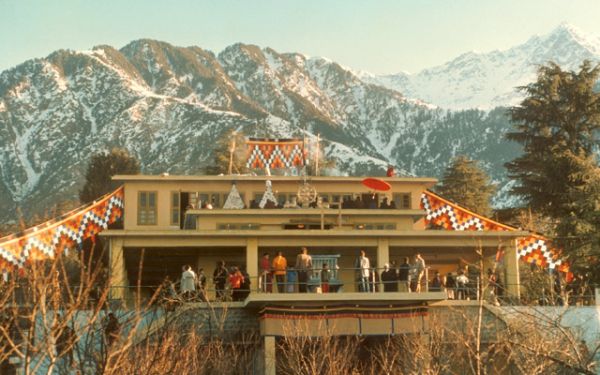
Lying on an undulating Dhauladhar spur of varying altitudes Dharamsala has become a fusion hub of Indo-Tibetan culture. The Buddha Temple, situated opposite the abode of His Holiness the Dalai Lama, houses larger than life statues of Buddha, Avloketshwara and Padmasambhava. Many famous rock stars, Hollywood actors, ordinary Buddhists and Tibetans visit Dharamsala round the year ever since the Dalai Lama settled at McLeodganj.
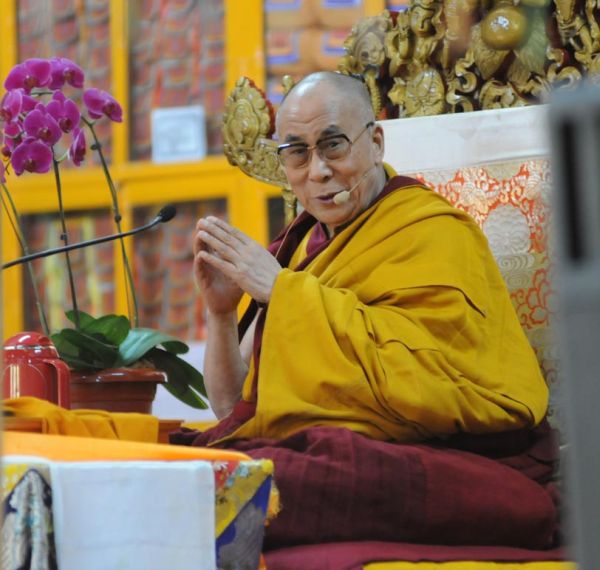
Important Hindu religious sites also abound around Dharamsala. Bhagsunath (11Km) is famous for its ancient temple. The fresh water spring besides this temple is considered sacred. The Chinmaya Tapovan (9 Kms) established by the late Swami Chinmayanand is a meditation, health and recreation centre. At Kunnal Pathri (3 Km) is a rock temple dedicated to the goddess Kapaleshwari. Believers hold Kunnal Pathri as a Shaktipeeth where part of the skull of goddess Sati fell. The Durgeshwara Temple(11 Km) besides the scenic small Dal Lake is revered by many. The Aghanjar Mahadev Temple (8.5 Km) near Khaniyara village is dedicated to Nag, as Lord of Snakes and the Lord of Rains.
The St. John’s Church In The Wilderness (8 Km) at Forsytheganj is where the grave of a former British Viceroy Lord Elgin lies. Craving for his homeland across the seas in Scotland, Dharamsala is where he chose to be buried in 1863. The large bell at this small Church does not ring anymore but the faithful do assemble to pray..

Masroor Temple (40 Km) easily accessible from Dharamsala is the only rock cut temple in North India. The scale and stone craft of this monument dedicated to Ram, Laxman and Sita sparks admiration.
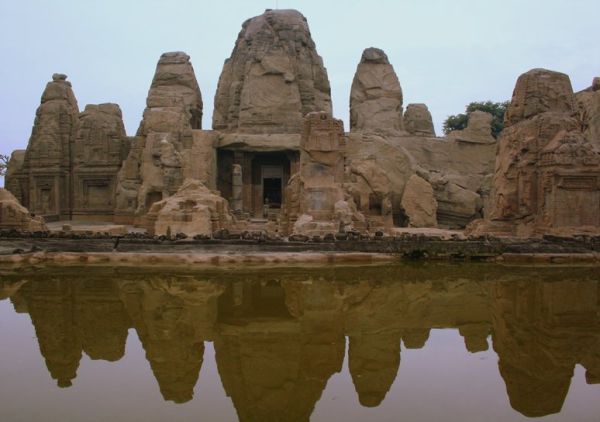
Getting there
Dharamsala can be reached by road. It is 514 Km from Delhi, 235 Km from Chandigarh, 252 Km from Shimla and 85 Km from Pathankot. The convenient rail head is at Pathankot whereas Kangra railway station on a narrow gauge railway line is only 17 Km from Dharamsala. Nearest airport at Gaggal is 12 Km away.
Circuit
Dharamsala holds pilgrimage interest for Buddhists, Hindus and Christians.
Climate
Summer is pleasant and light cotton clothing will do but winters are cold and heavy woollens are needed. Rains are severe at Dharamsala and rain protection gear helps.
Chamundaji (1000 m)
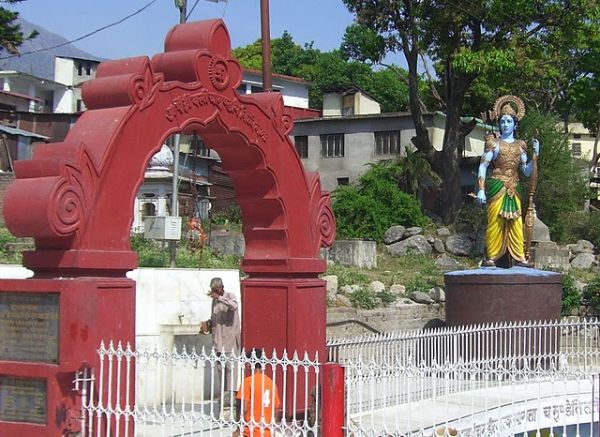
Many come to pay obeisance at the revered Chamunda Devi temple, located amidst scenic settings in the Dhauladhar ranges. The temple honouring the warring deity Chamundaji is located on the bank of rivulet Baner (also called Ban Ganga), a tributary of river Beas. The holy waters have been converged to allow pilgrims to take a holy dip at a bathing ghat. A temple glorifying Lord Shiva as Nandikeshwar in the temple complex is equally revered.
Getting there
Chamundaji is 105 Km from Pathankot, 15 Km from Dharamsala, 25 from Palampur and 284 Km from Shimla. Nearest broad gauge train station is at Pathankot. Kangra airport at Gaggal is 30 Kms away.
Circuit
Chamundaji along with Brijeshwari Devi (Kangra), Jwalamukhi, Chintpurni, and Deothsidh (Shahtalai) are integral to the popular pilgrim circuit of Kangra.
Climate
Summers are warm and cotton clothing will suffice, winters do get cold and woollens are needed.
Palampur: (1250 m)
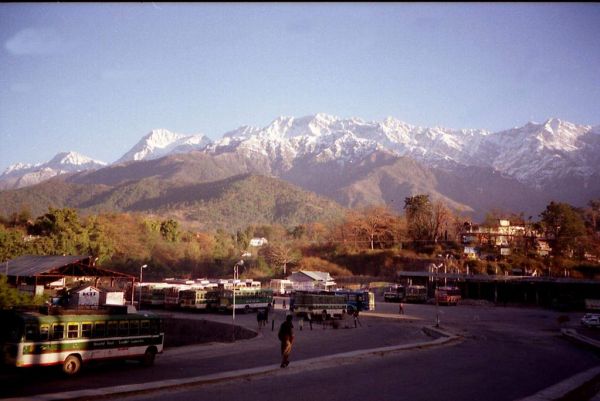
Palampur was founded by British tea planters. This hill station is still known for its tea gardens and colonial architecture. The white ranges of DhauladharMountains for a background give the place a magnificent dimension and in the vicinity are fine specimens of heritage status temples and flourishing monasteries.
St John’s Church In The Wilderness at Palampur is a relic from the British Raj days. Important Tibetan monastery at Tashijong (12 km) and Bir (24 Km) can be easily accessed from Palampur. These monastery complexes are famous for producing traditional Tibetan handicrafts.
Hindus count the Mahakal Temple (22 km) among one of two such temples dedicated to Lord Shiva in the country. The Shiva Temple at Baijnath (16 Km) is an exquisite thirteenth century temple, chiselled with fine stone craft. Sujanpur Tira, (42 km) harbours ruins of a old fort and some nicely preserved heritage temples that are adorned with beautiful wall paintings. The Chamunda Devi temple can also be easily accessed from Palampur.
Getting there
Palampur is 40 km from Dharamsala, 115 Kms from Pathankot, 259 Kms from Shimla and 545 Kms from Delhi. Nearest broad gauge train station is at Pathankot and the narrow gauge station of Moranda is 4 Kms away. The closest airport at Gaggal is 35 Km away.
Circuit
Palampur is a year round pilgrim destination for Buddhist, Hindus and Christians.
Climate
Palampur enjoys a cool climate amidst scenic surroundings. Cotton clothing in summer and woollens in winter is recommended.
Jogindernagar (1500 m)
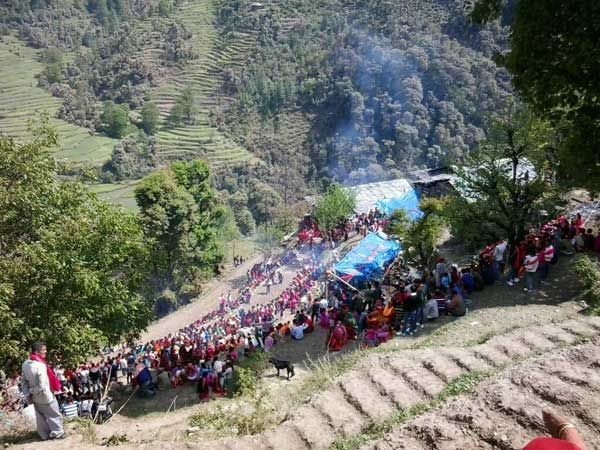
Jogindernagar is the terminal point of a 163 Km long Kangra valley narrow gauge rail line that starts from Pathankot. Bir (11 Km, 2080 m) that has a small Tibetan settlement with a beautiful monastery and the exquisitely sculpted Lord Shiva temple at Baijnath (20 Km, 1250 m) built in circa 804 A.D are of pilgrim interest in the vicinity of Jogindernagar.
Getting there
Jogindernagar is 163 Km by road from Pathankot, 56 Km from Mandi, 259 Km from Chandigarh and 210 Km from Shimla. Nearest broad gauge train stations are at Chandigarh and Pathankot. Nearest airports are at Gaggal (Kangra) 60 Kms and Bhuntar (Kullu) 115 Km away.
Circuit
Jogindernagar is a good base camp for visiting Buddhist and Hindu pilgrims.
Climate
Winter temperature does drop low and heavy woollens are required. Summers are pleasant and cottons are recommended.
Pilgrimage tourism in Kangra valley offers much variety.
- The deeply religious can take the Temple Tour which could be carved into a circuit starting from Hoshiarpur and after going through Chintpurni, Deothsidh, Jwalamukhi, Brijeshwari Devi (Kangra), Bhagsunath (Dharamsala) and Chamunda Devi, one can exit it at Pathankot.
- Those inclined more towards architecture and aesthetics, the Heritage Tour consisting of Masroor, Baijnath and Sujanpur Tira temples are of great interest.
- For the Buddhist there is the Monastic Tour which starts at Pathankot and goes through Dharamsala – McLeodganj, Palampur and Jogindernagar.
- Of Christian interest are the St John’s Churches In The Wilderness at Dharamsala-Forsytheganj and Palampur.

Could you please draw good itinerary circuit of various types so that it is convenient for us like people to start from one way and end the same or other side. Thnx